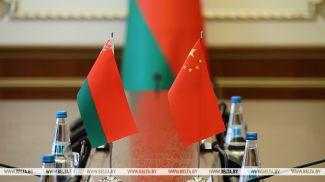
MINSK, 23 December (BelTA) – The film Time Chose Us on the Belarus 1 TV channel recalled the first congress of scientists in Belarus in the autumn of 2007, BelTA learned.

The congress was the largest scientific event in the post-Soviet space. it drew more than 2,500 delegates who presented about 500 solutions - from environmental conservation to space exploration. One of the main topics on the agenda was the use of intellectual potential in achieving economic growth, as well as the introduction of science-intensive products into production.

“In the new century, it is impossible to make progress without science. We have no time and money to move by touch without having a strong scientific footing,” said Belarusian President Aleksandr Lukashenko.
It was decided that hundreds of enterprises should increase their focus on research. The breakthrough of Belarusian science was noticeable at the international level. Our scientists developed one of key components of the Large Hadron Collider - a niobium resonator. Only two companies manufactured a similar product – those were industry giants from the USA and Japan.

Belarusians participated not only in the LHC development project, but also in operating detectors and obtaining scientific output.
“We also developed one of crucial elements of the ATLAS detector - the so-called electromagnetic calorimeter. The calorimeter is a subsystem of the detector that measures the energy of particles obtained as a result of proton collisions. As is known, the Large Hadron Collider generates collisions of proton particles, which are part of atomic nuclei, at the highest energy. As a result, many new different particles may appear,” said Head of the Fundamental Interactions and Astrophysics Center of the Institute of Physics of the National Academy of Sciences of Belarus, Doctor of Physics and Mathematics, Professor Yuri Kurochkin.

The congress was the largest scientific event in the post-Soviet space. it drew more than 2,500 delegates who presented about 500 solutions - from environmental conservation to space exploration. One of the main topics on the agenda was the use of intellectual potential in achieving economic growth, as well as the introduction of science-intensive products into production.

“In the new century, it is impossible to make progress without science. We have no time and money to move by touch without having a strong scientific footing,” said Belarusian President Aleksandr Lukashenko.
It was decided that hundreds of enterprises should increase their focus on research. The breakthrough of Belarusian science was noticeable at the international level. Our scientists developed one of key components of the Large Hadron Collider - a niobium resonator. Only two companies manufactured a similar product – those were industry giants from the USA and Japan.

Belarusians participated not only in the LHC development project, but also in operating detectors and obtaining scientific output.
“We also developed one of crucial elements of the ATLAS detector - the so-called electromagnetic calorimeter. The calorimeter is a subsystem of the detector that measures the energy of particles obtained as a result of proton collisions. As is known, the Large Hadron Collider generates collisions of proton particles, which are part of atomic nuclei, at the highest energy. As a result, many new different particles may appear,” said Head of the Fundamental Interactions and Astrophysics Center of the Institute of Physics of the National Academy of Sciences of Belarus, Doctor of Physics and Mathematics, Professor Yuri Kurochkin.
To learn more about the significant and momentous events of our history, please watch the BelTA YouTube project How It Was.













